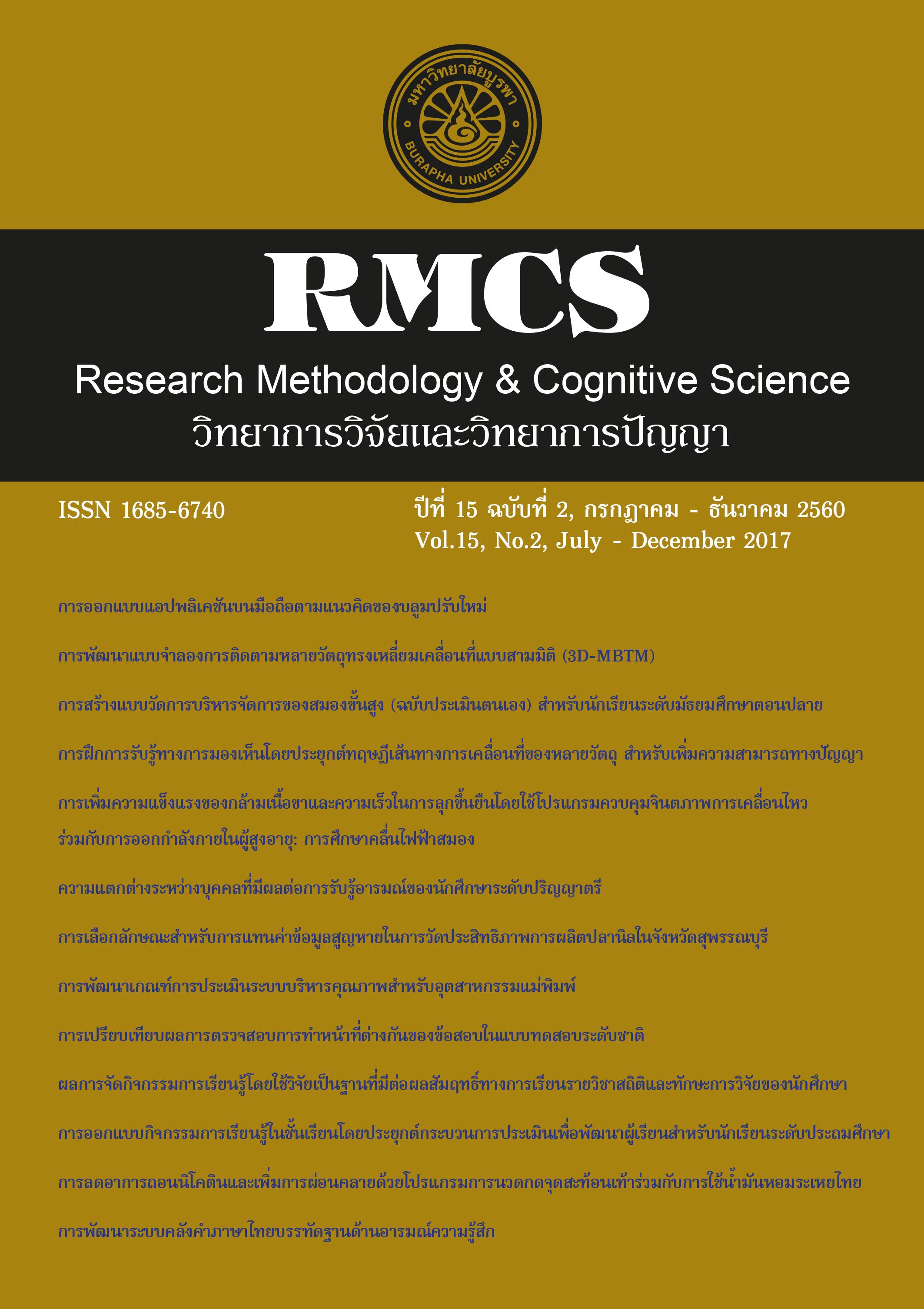Visual Perception Training by Applying the Theory of Motion Objects Tracking for Increasing Cognitive Ability in Lower Secondary School Students
Main Article Content
Abstract
Cognitive abilities are the brain-based skills, important for the students related to their learning,
intelligence, and thinking process. The objectives of this research were to defne visual perception
training model by applying the theory of motion objects tracking for increasing cognitive ability in
lower secondary school students and compared the cognitive ability between the experimental
and control groups after training. The participants were sixty male lower secondary school students
studying in the academic year 2015 at Assumption College Sriracha, Chon Buri. They were randomly
and equally assigned to experimental and control groups. The research instruments comprised
3D TV 65 inches, NeuroTracker, spatial ability test and semantic ability test. Basic statistics and
MANOVA were used to analyze the data.
The results showed that the model of visual perception training program by applying the
theory of motion objects tracking through 3D TV, including Presentation, Indexation, Movement,
Identifcation, and Feedback. After training with the program, the experimental group had cognitive
ability increase and higher than the control group (p<.01), the experimental group had spatial
ability higher than the control group (p<.01), and the experimental group had semantic memory
ability higher than the control group (p<.01).The results can be concluded that visual perception
training program by applying the theory of motion objects tracking (NeuroTracker) was capable of
increasing cognitive ability in lower secondary school students.
Article Details
References
1154-1164.
David, L. T. (2012). Training of spatial abilities through computer games–results on the relation between game›s task and psychological measures that are used. Procedia-Social and Behavioral Sciences,
33, 323-327.
Faubert, J. (2002). Visual perception and aging. Canadian Journal of Experimental Psychology, 56(3), 164-176.
Faubert, J., & Sidebottom, L. (2012). Perceptual-cognitive training of athletes. Journal of Clinical Sport Psychology, 6(1), 85-102.
Glover, S. (2004). Planning and control in action. Behavioral and Brain Sciences, 27(01), 57-69.
Glover, S., & Dixon, P. (2002). Dynamic effects of the Ebbinghaus illusion in grasping: Support for a planning/control model of action. Attention, Perception, & Psychophysics, 64(2), 266-278.
Khooshabeh, P., & Hegarty, M. (2010, March). Representations of Shape during Mental Rotation. In AAAI Spring Symposium: Cognitive Shape Processing.
Klingberg, T. Z2006X. Training working memory. The ADHD Repor, 14(1), 6-8.
Kuperman, V., & Van Dyke, J. A. (2011). Effects of individual differences in verbal skills on eyemovement patterns during sentence reading. Journal of Memory and Language, 65(1), 42-73.
Legault, I., Allard, R., & Faubert, J. (2013). Healthy older observers show equivalent perceptual-cognitive training benefts to young adults for multiple object tracking. Frontiers in Psychology, 4(323), 1-7.
Legault, I. & Faubert, J. (2012). Perceptual-cognitive training improves biological motion perception: evidence for transferability of training in healthy aging. Neuroreport, 23(8), 469-473.
Menzel, R. & Giurfa, M. (2001). Cognitive architecture of a mini-brain: the honeybee. Trends in Cognitive Sciences, 5(2), 62-71.
Olsen, R. K., Sebanayagam, V., Lee, Y., Moscovitch, M., Grady, C. L., Rosenbaum, R. S., & Ryan, J. D. (2016). The relationship between eye movements and subsequent recognition: Evidence from individual
differences and amnesia. Cortex, 85, 182-193.
Penphu, W., & Kornpetpanee, S. (2017). Enhancing the visual perception ability of motorcycle taxi riders using a 3D motion object tracking training program. Research Methodology & Cognitive Science,
15(1), 54-64.
Pylyshyn, Z. W. (2001). Visual indexes, preconceptual objects, and situated vision. Cognition, 80(1), 127-158.
Rauscher, F. & Zupan, M. (2000). Classroom keyboard instruction improves kindergarten children's spatialtemporal performance: a feld experiment. Early Childhood Research Quarterly, 15(2), 215-228.
Small, G. W., Silverman, D. H., Siddarth, P., Ercoli, L. M., Miller, K. J., Lavretsky, H., ... & Phelps, M. E. (2006). Effects of a 14-day healthy longevity lifestyle program on cognition and brain function.
The American journal of geriatric psychiatry, 14(6), 538-545.
Tanudtanusilp, P., Kornpetpanee, S., & Ruangtip, P. (2017). Increasing spatial recognition ability using three dimensional multiple object tracking (3D – MOT) task for upper secondary school students:
an electroencephalogram study. Research Methodology & Cognitive Science, 15(1), 73-92.
Van Zoest, W., & Hunt, A. R. (2011). Saccadic eye movements and perceptual judgments reveal a shared visual representation that is increasingly accurate over time. Vision research, 51(1), 111-119.
